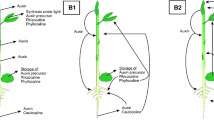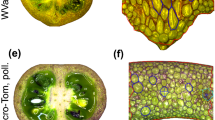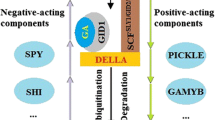Abstract
Tomato (Lycopersicon esculentum Mill.) plants homozygous for the mutant pro gene, exhibiting the distinctive procera phenotype, appeared virtually identical to gibberellic acid (GA3)-treated isogenic normal plants. The pro gene and GA3 caused analogous increases in internode length, and in the length and number of cells in the outer cell layers of each internode. Internode number was also increased by pro and GA3 over the period of the experiment. Despite their greater length, the internodes of GA3-treated and pro plants reached their final size within a time period similar to that of internodes of untreated normal plants. The pro mutant itself was responsive to GA3, especially in the seedling stage, but the proportional increase in height seen in the later stages of growth was less than that of normal plants.
Similar content being viewed by others
Abbreviations
- GA:
-
gibberellin
- GA3 :
-
gibberellic acid
- LSD:
-
least significant difference
References
Arney, S.E., Mancinelli, P. (1966) The basic action of gibberellic acid in elongation of ‘Meteor’ pea stems. New Phytol. 65, 161–175
Brummell, D.A., Hall, J.L. (1980) The role of the epidermis in auxin-induced and fusicoccin-induced clongation of Pisum sativum stem segments. Planta 150, 371–379
Bukovac, M. J., Honma, S. (1967) Gibberellin-induced heterostyly in the tomato and its implication on hybridization. Proc. Am. Soc. Hort. Sci. 91, 514–520
Butcher, D.N. (1986) Chemical and genetical manipulation of endogenous plant hormones. In Long Ashton Research Station Report 1984, p. 11
Buttrose, M. S., Mullins, M. G. (1968) Proportional reduction in shoot growth of grapevines with root systems maintained at constant relative volumes by repeated pruning. Aust. J. Biol. Sci. 21, 1095–1101
Cavalier-Smith, T. (1985) Genetic and epigenetic control of the plant cell cycle. In: The cell division cycle in plants, pp. 179–197, Bryant, J.A., Francis, D., eds, Cambridge University Press, Cambridge, UK
Darby, L.A., Ritchie, D.B., Taylor, I.B. (1978) Isogenic lines of the tomato ‘Ailsa Craig’. In: The Glasshouse Crops Research Institute Annual Report 1977, pp. 168–184
Duncan, D.B. (1955) Multiple range and multiple F tests. Biometrics 11, 1–42
Firn, R., Digby, J. (1977) The role of the peripheral cell layers in geotropic curvature of sunflower hypocotyls: a new model of shoot geotropism. Aust. J. Plant Physiol. 4, 337–347
Gray, R.A. (1957) Alteration of leaf size and shape and other changes caused by gibberellins in plants. Am. J. Bot. 44, 674–682
Hameed, M.A., Reid, J.B., Rowe, R.N. (1987) Root confinement and its effects on the water relations, growth and assimilate partitioning of tomato (Lycopersicon esculentum Mill.). Ann. Bot. 59, 685–692
Hepler, P. K., Wayne, R. O. (1985) Calcium and plant development. Annu. Rev. Plant Physiol. 36, 397–439
Jones, M.G. (1987) Gibberellins and the procera mutant of tomato. Planta 172, 280–284
Jones, R.L. (1973) Gibberellins: their physiological role. Annu. Rev. Plant Physiol. 24, 571–598
Jones, R.L. (1980) The physiology of gibberellin-induced elongation. In: Plant Growth Substances 1979, pp. 188–195, Skoog, F., ed. Springer, Berlin
Kutschera, U., Bergfeld, R., Schopfer, P. (1987) Cooperation of epidermis and inner tissues in auxin-mediated growth of maize coleoptiles. Planta 170, 168–180
Moll, C., Jones, R.L. (1981) Calcium and gibberellin-induced elongation of lettuce hypocotyl sections. Planta 152, 450–456
Pearce, D., Penny, D. (1983) Tissue interactions in indole-acetic acid-induced rapid elongation of lupin hypocotyls. Plant Sci. Lett. 30, 347–353
Phinney, B.O. (1984) Gibberellin A1, Dwarfism and the control of shoot elongation in higher plants. In: The biosynthesis and metabolism of plant hormones, pp. 17–41, Crozier, A., Hillman, J.R. Eds. Cambridge University Press, Cambridge, UK
Potts, W.C., Reid, J.B., Murfet, I.C. (1985) Internode length in Pisum. Gibberellins and the slender phenotype. Physiol. Plant. 63, 357–364
Rappaport, L. (1957) Effect of gibberellin on growth, flowering and fruiting of the Earlypak tomato, Lycopersicon esculentum. Plant Physiol. 32, 440–444
Stoddart, J.L. (1987) Genetic and hormonal regulation of stature. In: Development mutants in higher plants, pp. 155–180, Thomas, H., Grierson, D., eds., Cambridge University Press, Cambridge, UK
Stoddart, J.L., Lloyd, E.J. (1986) Modification by gibberellin of the growth-temperature relationship in mutant and normal genotypes of several cereals. Planta 167, 364–368
Stuart, D.A., Durnam, D.J., Jones, R.L. (1977) Cell elongation and cell division in elongating lettuce hypocotyl sections. Planta 135, 249–255
Stubbe, H. (1957) Mutanten der Kulturtomate Lycopersicon esculentum Miller I. Kulturpflanze 5, 110–220
Theologis, A. (1986) Rapid gene regulation by auxin. Annu. Rev. Plant Physiol. 37, 407–438
Author information
Authors and Affiliations
Rights and permissions
About this article
Cite this article
Jupe, S.C., Causton, D.R. & Scott, I.M. Cellular basis of the effects of gibberellin and the pro gene on stem growth in tomato. Planta 174, 106–111 (1988). https://doi.org/10.1007/BF00394881
Received:
Accepted:
Issue Date:
DOI: https://doi.org/10.1007/BF00394881




